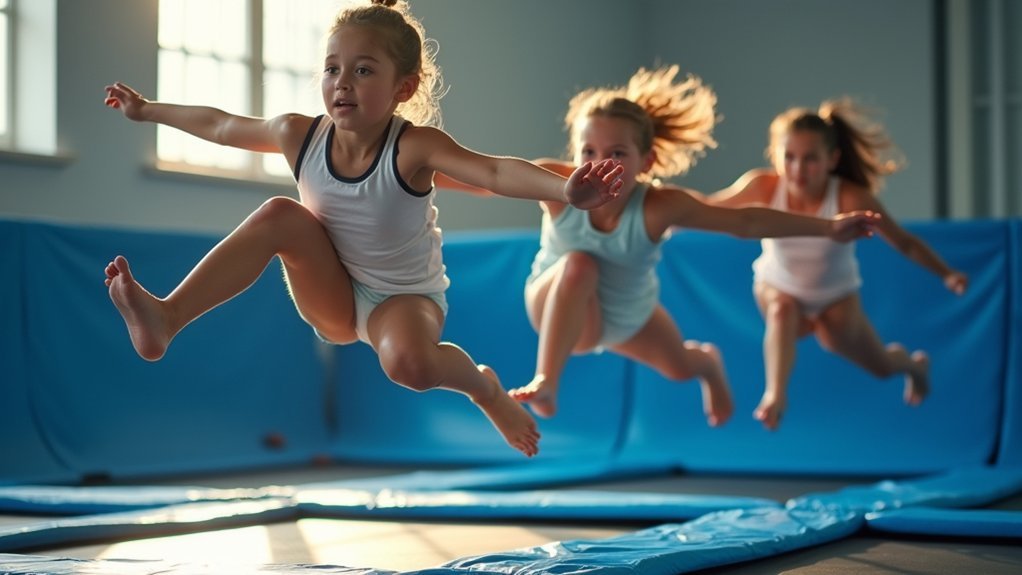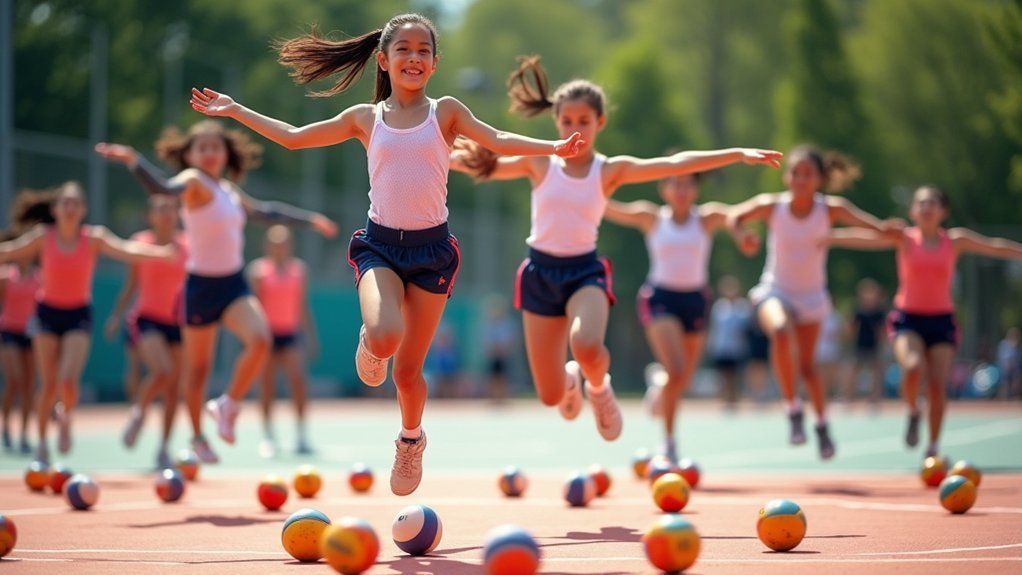Synchronization training on a mini trampoline builds superior coordination through five key mechanisms: neural timing enhancement that improves brain-muscle communication, bilateral harmony development that engages both body sides simultaneously, proprioceptive recalibration that enhances spatial awareness, rhythmic adaptation that optimizes muscle recruitment, and cross-body coordination that strengthens neural pathways. You’ll experience faster reaction times, improved balance, and more efficient movement patterns. Discover how these mechanisms transform your everyday movements and athletic performance in just minutes per day.
Neural Timing: How Rebounding Synchronizes Brain-Muscle Communication

When you bounce on a rebounder, your brain and muscles engage in a sophisticated dance of communication that enhances your overall coordination. The vertical movements stimulate your vestibular system, creating a unique training environment for neural timing improvements.
Each bounce activates motor units more efficiently, as your body adapts to the rhythmic contraction and relaxation patterns. This consistent stimulation increases synaptic plasticity, allowing your brain to optimize the pathways responsible for muscle activation.
The rhythmic bounce-and-release cycle rewires neural pathways, creating more efficient muscle recruitment with every jump.
You’re fundamentally rewiring your brain-muscle communication with every jump. The repetitive nature of rebounding aligns perfectly with your brain’s timing mechanisms, leading to faster reaction times and more precise movements.
This enhanced synchronization translates directly to improved athletic performance, as your body becomes more responsive in dynamic situations requiring complex coordination.
Bilateral Harmony Through Mini Trampoline Oscillations
As you bounce on a mini trampoline, your body naturally develops bilateral harmony through the rhythmic oscillations that engage both sides simultaneously.
This synchronization creates a foundation for improved coordination as your limbs learn to work together in perfect rhythm.
The dynamic bouncing challenges your vestibular system, enhancing balance and spatial awareness with each rebound.
Your muscles respond with increased activation patterns, developing more efficient intermuscular coordination across your entire body.
Mini trampoline training sharpens your neuromuscular responses by demanding quick adjustments to maintain stability.
You’ll notice these benefits transfer directly to improved athletic performance and agility in daily activities.
The continuous oscillatory movements create a perfect environment for both sides of your body to communicate effectively, establishing balanced strength and coordinated movement patterns that serve you in all physical endeavors.
Proprioceptive Recalibration During Rebounding Exercises

The dynamic surface of a rebounder creates an ideal environment for proprioceptive recalibration, challenging your body’s internal positioning system with each bounce.
As you train, multiple muscle groups engage simultaneously, enhancing your spatial awareness and balance while your neuromuscular control adapts to the unstable platform.
You’ll notice your coordination improving as proprioceptive feedback becomes more refined, enabling smoother movement patterns and quicker reaction times.
This isn’t coincidental—your brain is experiencing neuroplastic changes that optimize neural pathways for movement execution.
By consistently incorporating rebounding into your training regimen, you’re facilitating the synchronization between your brain’s commands and your body’s responses.
The result? Superior coordination that transfers to daily activities and athletic performance, all through the seemingly simple act of rhythmic bouncing.
Rhythmic Adaptation and Muscle Recruitment Patterns
Your body’s remarkable capacity for rhythmic adaptation fundamentally transforms how muscles are recruited during synchronized movement.
When you engage in repetitive training that emphasizes rhythm, your central nervous system develops organized patterns of muscle activation specifically tailored to your activities.
This synchronization directly enhances your athletic performance by optimizing motor unit recruitment—you’ll generate greater force without necessarily building larger muscles.
As you train rhythmically, your body develops intrinsic muscle synergies essential for executing complex movements with remarkable efficiency.
Research confirms that this type of coordination training considerably reduces movement variability during high-intensity activities, helping you maintain stability when it matters most.
The result is smoother execution of complex movements and more consistent performance, giving you a competitive edge through neurological adaptation rather than just physical development.
Cross-Body Coordination Enhancement via Rebound Stabilization

While traditional training often focuses on isolated movements, cross-body coordination through rebound stabilization offers a revolutionary approach to athletic development. By jumping on a rebounder or trampoline, you’ll engage both sides of your body simultaneously, strengthening neural pathways between brain hemispheres.
- Dynamic movements on rebounding surfaces challenge your balance and stimulate proprioception, enhancing your spatial awareness for complex motor skills.
- Muscle activation occurs across multiple groups during rebound stabilization, improving synchronized contractions essential for efficient movement patterns.
- Coordination training that incorporates cross-body exercises reduces injury risk through balanced muscle development.
You’ll notice improved movement efficiency as your brain adapts to these challenging exercises, making rebound stabilization a valuable addition to any athlete’s training program.
Frequently Asked Questions
What Type of Training Is Best for Coordination?
You’ll develop superior coordination through specific, varied exercises like agility ladder drills, balance training, and sport-specific movements. Practice consistently 2-3 times weekly, focusing on multi-joint exercises that integrate timing and spatial awareness.
What Are the Benefits of Oscillation Training?
Oscillation training improves your coordination through rapid muscle activation cycles. You’ll develop faster reaction times, enhanced metabolic efficiency, and greater movement control while applying targeted intensity within specific motion ranges.
In Summary
You’ve now discovered how rebounding transforms your coordination through neural timing, bilateral harmony, proprioceptive awareness, rhythmic adaptation, and cross-body stabilization. When you’re bouncing regularly, you’re rewiring your brain-muscle connections for superior synchronization. Your body learns to work as a coordinated unit rather than disconnected parts. Try incorporating these techniques into your routine, and you’ll notice improvements in everything from sports performance to daily movements.





Leave a Reply